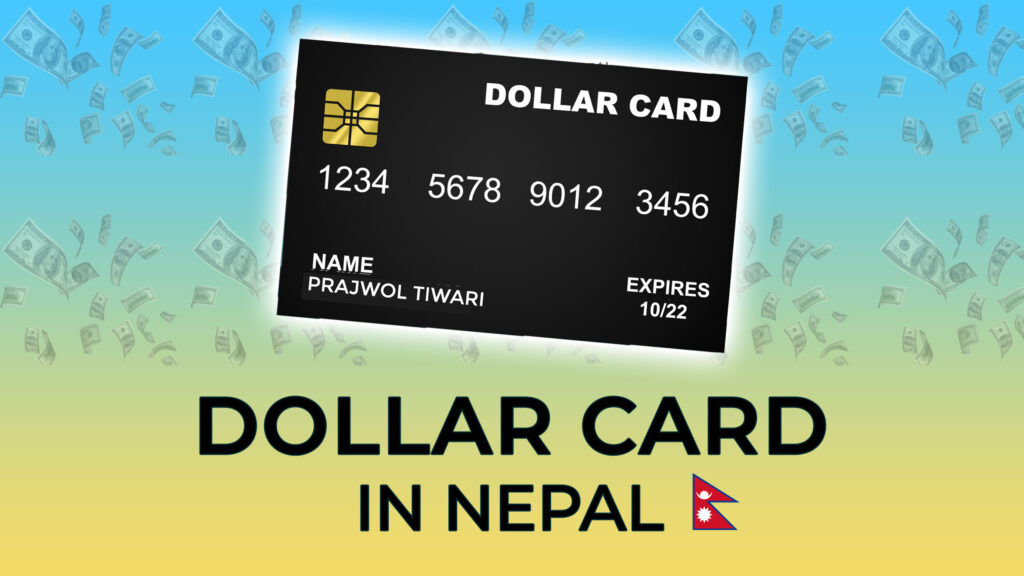Are you looking to make payments in US Dollars from Nepal? If so, you may want to consider getting a Dollar Card, a pre-paid card that can be used for online transactions and payments in USD. In Nepal, all class A commercial banks and class B development banks offer Dollar Cards to their customers. Here’s how you can get one:
Find a bank that offers Dollar Card: First, you need to identify a bank that offers Dollar Card in Nepal. Here’s a list of commercial banks and development banks in Nepal that offer this service:
List of Commercial Banks in Nepal:
- Standard Chartered Bank Nepal Limited
- Nepal Investment Bank Limited
- Nabil Bank Limited
- Himalayan Bank Limited
- Global IME Bank Limited
- Nepal SBI Bank Limited
- Everest Bank Limited
- NIC Asia Bank Limited
- Mega Bank Nepal Limited
- Sanima Bank Limited
- Sunrise Bank Limited
- Prime Commercial Bank Limited
- Civil Bank Limited
- Laxmi Bank Limited
- Kumari Bank Limited
List of Development Banks in Nepal:
- Lumbini Bikas Bank Limited
- Garima Bikas Bank Limited
- Miteri Development Bank Limited
- Mahalaxmi Bikas Bank Limited
- Kamana Sewa Bikas Bank Limited
- Kankai Bikas Bank Limited
Get a personal bank account: To get a Dollar Card, you need to have a personal bank account with the bank that offers this service. You cannot get a Dollar Card from a company bank account.
Fill out a form: You can get a form for the Dollar Card at the front desk of the bank. Fill out the form with the necessary details and submit it to the bank.
Wait for the card details: Within two days of submitting the form, you will receive an email from the bank with your card details. The email will contain two password-protected documents: one with your card details and another with your CVV. The password pattern will be sent to you via SMS.
Load money onto the card: Depending on the bank, you may be charged a fee for loading money onto the card. This fee can be up to 500 NPR per recharge. You can transfer the amount directly from your primary bank account (savings/current account) into the Dollar Card. It’s not necessary to load the entire 500 USD at once; you can load any amount as per your requirement.
Use the card: Once you have loaded money onto the card, you can use it to make payments in USD for various online services, such as Facebook and Instagram ads, online courses on platforms like Coursera and Udemy, online streaming services like Netflix and Spotify, and online shopping on platforms like Amazon.
Please note that you cannot use the Dollar Card to transfer funds to other accounts or receive funds from other accounts.
Making international payments from Nepal can be challenging due to a few reasons:
- Lack of direct banking relationships with other countries: Nepal’s banking sector is relatively small and has limited direct relationships with banks in other countries. This can make it difficult to initiate international payments directly from Nepali banks
- Limited use of electronic payment systems: Many Nepali banks still rely on manual processes for international payments, which can be time-consuming and prone to errors. Moreover, Nepal’s electronic payment systems are not as advanced as those in other countries, which can further complicate international transactions.
- Stringent foreign exchange regulations: Nepal has stringent foreign exchange regulations that are designed to control the outflow of foreign currency from the country. These regulations require individuals and businesses to obtain approval from the central bank for certain types of international transactions, such as remittances and foreign investments. This can add to the complexity and time required to make international payments.
- Limited access to international payment systems: Nepali banks have limited access to international payment systems such as SWIFT and PayPal, which can make it difficult to initiate and receive international payments. This is partly due to the small size of Nepal’s banking sector and the country’s relatively low level of integration with the global financial system.
Overall, these factors contribute to the difficulty of making international payments from Nepal. However, efforts are being made to improve the country’s payment infrastructure and increase its integration with the global financial system. For example, the central bank of Nepal has recently introduced new regulations to promote electronic payments and improve access to international payment systems.

Brief history of Nepal Rastriya Bank (NRB) and it’s recent policies:
Nepal Rastriya Bank (NRB) is the central bank of Nepal and was established in 1956. Its primary objective is to formulate and implement monetary policy and regulate the banking and financial sector in the country.
Initially, the central bank’s policies focused on maintaining price stability and promoting economic growth. In the early years, NRB’s policies were geared towards promoting agricultural production, which was the mainstay of the Nepali economy at the time. The central bank also worked to modernize the banking sector, which was relatively underdeveloped at the time.
Over the years, NRB’s policies have evolved to focus on promoting financial inclusion and stability. The central bank has implemented various measures to increase access to financial services and promote financial literacy among the Nepali population. For example, NRB has introduced policies to encourage banks to open branches in rural areas and provide loans to small businesses.
In recent years, NRB has also taken steps to support Nepali citizens during times of crisis. For example, during the COVID-19 pandemic, the central bank introduced a number of measures to provide relief to individuals and businesses affected by the pandemic. These measures included loan repayment moratoriums, interest rate reductions, and support for affected industries.



Pingback: SVB Collapse. What can NRB learn from it? – FromEverest